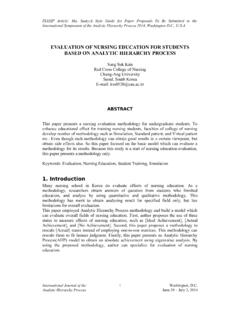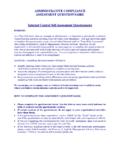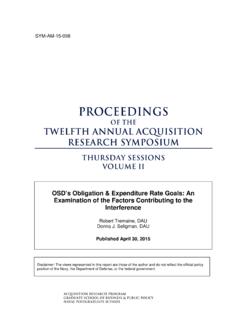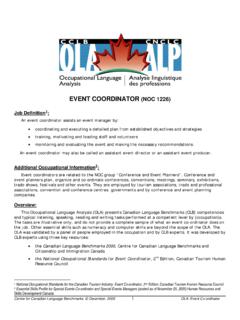Transcription of PERFORMANCE MEASUREMENT OF INSURANCE …
1 *Corresponding author PERFORMANCE MEASUREMENT OF INSURANCE companies BY USING BALANCED SCORECARD AND ANP Ronay Ak* Istanbul Technical University, Faculty of Management Istanbul, Turkey Email: Ba ar ztay i Istanbul Technical University, Faculty of Management Istanbul, Turkey Email: ABSTRACT The balanced scorecard (BSC) is a strategic planning and management system that has wide applications in manufacturing and service industries. The main goals of BSC are to align business activities to the vision and strategy of the organization, improve internal and external communications, and monitor organization PERFORMANCE against strategic goals. In this study, PERFORMANCE MEASUREMENT is defined as an evaluation of the past activities with respect to the desired goals. First a balanced scorecard based PERFORMANCE MEASUREMENT system is proposed for INSURANCE companies .
2 Then perspectives that were obtained from BSC approach are quantified by Analytical Network Process (ANP). Key words: analytical network process, balanced scorecard, INSURANCE company, PERFORMANCE MEASUREMENT . 1. Introduction PERFORMANCE MEASUREMENT Systems (PMS) plays a key role for business organizations. PMS aims to implement a strategy for the organization. Many researches have shown that conventional financially based PERFORMANCE MEASUREMENT systems have failed to measure and integrate all the factors critical to success of a business. To deal with the new environment, new PMS have been proposed such as BSC, Activity Based Cost System, the SMART system, etc (Suwignjo, et al., 2000). The balanced scorecard (BSC) is a strategic planning and management system that has wide applications in manufacturing and service industries.
3 The main goals of BSC are to align business activities with the vision and strategy of the organization, improve internal and external communications, and monitor organization PERFORMANCE against strategic goals. It was first introduced by Kaplan and Norton in 1992. The balanced scorecard approach generally split strategic measures into one of the following: outcome or driver measures, financial or non-financial measures, and internal or external measures (Gautreau, et al., 2001). Using these different types of measures, the scorecard measures organizational PERFORMANCE in terms of four balanced perspectives: financial, customers, internal business process, and learning and growth (Kaplan et al., 1996). The aim of this paper is to apply a BSC based PMS to INSURANCE companies .
4 First a questionnaire was prepared based on the four perspectives mentioned above and send the three leading INSURANCE companies in Turkey. The companies were asked to score perspectives according to their importance level and compare perspectives and sub-criteria between each others. Then, questionnaire results were evaluated to select appropriate PERFORMANCE measures under each of perspectives. Finally, by using the selected criteria and sub-criteria an ANP model was designed and results were discussed in conclusion section. The remainder of this paper has been organized as follows: In section 2, we review existing PERFORMANCE MEASUREMENT models from the literature. Then, we present our proposed model for INSURANCE companies in Section 3. Finally, we summarize our study by some concluding remarks in section 4.
5 2. Literature Review Recently studies about company PERFORMANCE MEASUREMENT system not only focus on financial measurements but also non-financial measurements. There are both quantitative and qualitative methods presented to measure organization PERFORMANCE . Suwingjo et al. (2000) presented a quantitative based PERFORMANCE MEASUREMENT (PM) approach (QMPMS) with four steps to describe works at the Centre for Strategic Manufacturing, University of Strathclyde. First, they elaborated the factors affecting PERFORMANCE and their relationships. In the second phase, cause and effect diagrams were used to identify the hierarchical structure of the factors. After this step, a tree diagram was used to give a clearer picture of the hierarchical structure. Finally, Analytic Hierarchy Process (AHP) was used to quantify the relative effects of the factors (direct, indirect, and combined).
6 Bourne et al. (2000), proposed to divide the development of PERFORMANCE MEASUREMENT systems into three main phases: the design, the implementation and the use of PERFORMANCE measures. Then, these phases also split into various numbers of subdivisions. They pointed that measures are derived from strategies. Lohman et al. (2004), provided empirical results on improving PERFORMANCE MEASUREMENT systems to support supply chain management, using a case study methodology. They compared these empirical results with the literature and obtained new theoretical insights. Then, these findings were based on a case study at European Operations of Nike. Folan et al. (2005) described the evolution of PERFORMANCE MEASUREMENT in four sections: recommendations, frameworks, systems and inter-organizational PERFORMANCE MEASUREMENT .
7 They also compared various PERFORMANCE MEASUREMENT systems according to their framework typology and dimensions of MEASUREMENT . Framework typology was classified into two classes: structural and procedural. They also emphasized the importance of inter-organizational PM policy for the future of PM. Although there are many studies on PERFORMANCE MEASUREMENT systems for organizations, there are not enough applications on INSURANCE companies . Hence, this study focused on PERFORMANCE MEASUREMENT of INSURANCE companies .. 3. Proposed Model As mentioned before, this study aims to present a model and apply it to INSURANCE companies to obtain a PERFORMANCE score per period. Hence, we need quantitative data related to the companies PERFORMANCE . Questionnaires enable us to gather quantitative data related to the companies .
8 After questionnaire results, we selected following balanced perspectives and PERFORMANCE measures: Financial Perspectives (F) Total revenue (F1) Cost reduction percentage (F2) Profit rate (percentage) (F3) Return on investment (percentage) (F4) Customer Perspectives (C) Customer satisfaction rate (percentage) (C1) Cross selling percentage (C2) New customer acquisition rate (percentage) (C3) Customer retention rate (percentage) (C4) Internal Business Process Perspectives (P) Number of new products (P1) Service error rate (percentage) (P2) Mean-time response to a service call (hours) (P3) Customer complaints rate (percentage) ( P4) Learning and Growth Perspectives (L) Implementation rate for strategic plans (percentage) (L1) Mean-time to re-skilling per employee (hours) (L2) Investment rate in information technology and systems (L3) Customer satisfaction rate (percentage) (L4)
9 We designed an ANP model by using these criteria and sub-criteria. Figure I illustrate our ANP model s logical design. Our goal is to calculate corporate PERFORMANCE score. Then we formed pair wise comparison matrixes, where the number in the ith row and jth column gives the relative importance of Oi as compared with Oj, by using a 1-9 scale with 1 = if the two objects are equal in importance 3 = if Oi is weakly more important than Oj 5 = if Oi is strongly more important than Oj 7 = if Oi is very strongly more important than Oj 9 = if Oi is absolutely more important than Oj Loop in a cluster indicates inner dependence of the elements in that affect other elements of the same cluster ANP model s logical design Table I shows a comparison matrix of perspectives. These matrixes were filled out according to expert opinions.
10 In our ANP model as indicated in Figure 2, financial perspective depends on customer and internal business process perspectives. Customer perspective also depends on internal business process and learning and growth perspectives. Dependence of Perspectives Table 1. Comparison matrix for perspectives absolutely more important very strongly more important strongly more important weakly more important two objects are equal weakly more important strongly more important very strongly more important absolutely more important 9 7 5 3 1 3 5 7 9 F X C F X P F X L C X P C X L P X L After we had compared criteria and sub-criteria, we obtained weights of each sub-criteria illustrated as Table 2. We also calculated ratings by using Analytical Hierarchy Process (AHP).











